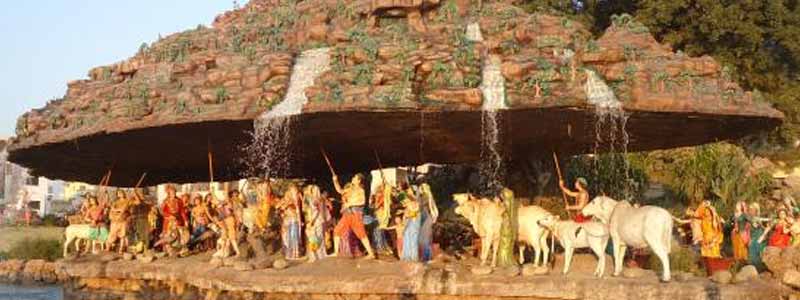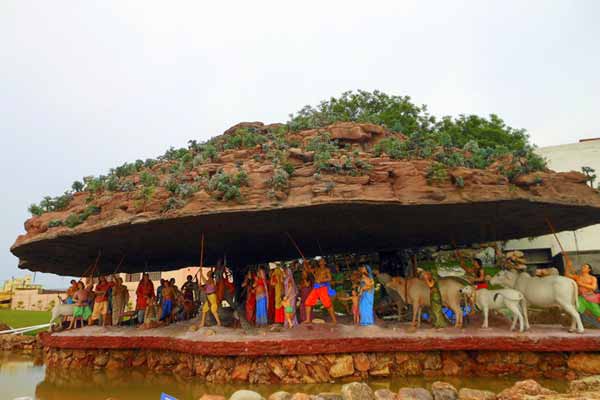Places to visit in Govardhan Located at a distance of 23 km to the west of Mathura, Govardhan is an important place of religious importance in Uttar Pradesh among the Hindus. The narrow hill of Giriraj which is made up of sandstone and is 8 km in length houses the famous “Govardhan Hills”. The Govardhan Hill is associated with Lord Krishna. People from far and wide of India come to worship the “Govardhan Parvat” to seek divine blessings from Lord Krishna.
According to a historical legend, Lord Krishna had once lifted the entire Giriraj Hill on his finger tip for seven days and nights to save the people of Braj from torrential rain. It is said that Lord Indra had become very jealous of the little boy with divine powers and so He decided to show His strength and power by bringing down heavy rain in the area. However, Lord Krishna saved the people by lifting the mountain.
The city of Govardhan is adjacent to a large tank known as the “Mansi Ganga”. The people of this area still believe that the tank was the result of “Divine Intervention” by Lord Krishna, Places to visit in Govardhan.
Govardhan has a long religious history and thousands of devotees flock the area during the time of festivals.
The famous temple of Haridev and the Kusum Sarovar also attracts many devotees from all over the world. Many foreigners also visit the place in search of “Truth” and peace.
The Govardhan Hills look spectacular on a moon lit night which captures the imagination of a poet. It is said that if one takes a round of the Divine Hill, he or she will receive eternal blessings Places to visit in Govardhan.

Places & Temples to visit in Govardhan
“Govardhan” or “Giriraj Ji” – the name itself reminds us of Lord Krishna as one of his names is Shri Govardhannathji! Since childhood, every one of us has heard the beautiful story of Indramaanbhang Leela many times and we surprise ourselves as to how a child lifted Shri Govardhan Parvat for seven days or how a child killed so many Asuras? In this blog, we take you to the best Govardhan Parikrama places that come in parikrama marg, distance to cover those places, and best time to do parikrama.
Vraj Bhumi is the only sacred place where you can see the location of all those leelas of shri Krishna that resides in the district of Mathura, Uttar Pradesh. You are one of the luckiest people if you’re planning to visit there and willing to feel the existence of Lord Krishna at every corner of the Vraj!
Daan-Ghati Mandir
Daan Ghati is a temple where deity is believed to be in the form of a rock, which is said to be going down in earth by a few millimetres every year. Local people, who have been witnessing this, confirm it, though there is no scientific proof Vrindavan Mathura Tour Package.
Goverdhan Parikrama
Govardana Parikrama (going 21 kilometres around the path) is a sacred ritual performed by many believers as spiritual purification. There is no time limit for performing this Parikrama. This ritual of Parikrama is considered to be even better if it’s done with milk. A clay pot filled with milk, with a hole at the bottom, is carried by the devotees in one hand and a pot filled with dhoop (incense smoke) in another. An escort continuously fills up the pot with milk till the parikrama is completed Places to visit in Govardhan.
Radha Kunda
Radha Kunda (well) is known to be the sacred bathing place of Radharani. She had rebuked Krishna, saying that he became impure by killing a bull, the symbol of religion. She suggested that he could purify himself by taking bath in all holy rivers.
Rather than travelling to all sacred places, he struck the ground with his heel and water from all holy rivers appeared. The place was then known as Shyama-kunda. In a competitive mood, the Gopis led by Radharani also created a kunda by digging the earth with their bangles. Thus, Radha kunda appeared Places to visit in Govardhan.
Mansi Ganga Kunda
Manasi Ganga used to be a large lake, but has gotten much smaller over the years. It is said that Radharani and Krishna would go boating on this lake. Even though it is a large, there are buildings blocking it, so you can barely see it from the road. But, ask anyone and chances are they will know where it’s located.
Kusum Sarovar
25-minute walk from Radha Kunda, this sandstone monument is usually a peaceful place, not visited by many people. The ghats at this kunda and the buildings above were built in 1764, by Jawahir Singh, the king of Bharatpur, in honour of his father Raja Suraj Mall. The main tomb has beautiful paintings on its ceiling Places to visit in Govardhan.
Mukharvind of ShreeNathji at Jatipura
Hundreds of devotees visit this temple daily to worship with milk and flowers. Many of them begin their Govardhan Parikrama from this point. The place is always alive with positive vibrations and energy.
Best Time For Govardhan Parikrama
Kusum Sarovar remains open for tourists throughout the year even on public holidays. However, considering the weather in Mathura, October to March end is the best season to plan a trip to Govardhan and its nearby places. Owing to extreme temperature in summer (April-July), planning a vacation to this beautiful place is not recommended during this time.
Govardhan Parikrama Distance
The entire Govardhan Parikrama is around 23 km. Usually, it takes 5-6 hours to complete the parikrama.
How to reach?
Located just 28 km away from Mathura, Kusum Sarovar is on the right side of Govardhan parikrama route. It can be easily reached by local transports like taxi, auto-rickshaw from Mathura. Located 26 km from Kusum Sarovar, Mathura railway junction is the nearest railway station. Situated at a distance of 191 km, Indira Gandhi International Airpot, New Delhi is nearest one to this place.
